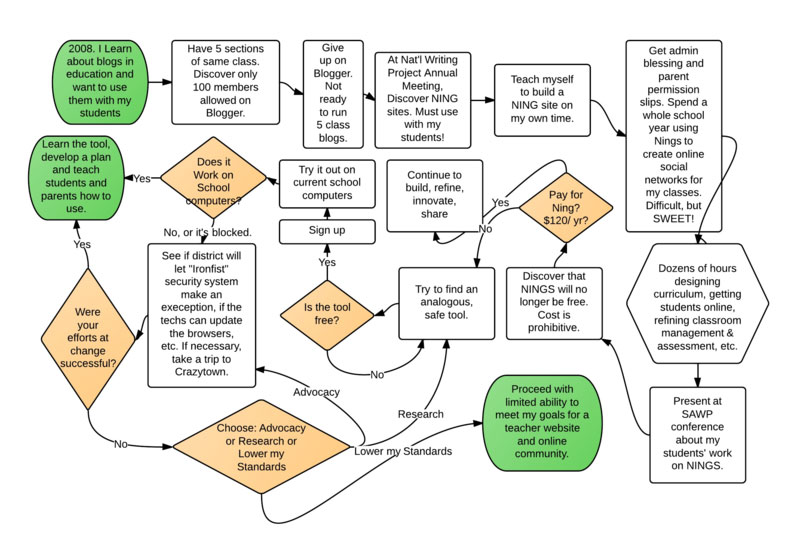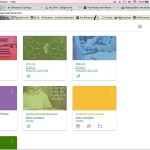What if school systems were responsive enough to keep up with the pace of technology?
When it comes to my ability to integrate an online learning experience for my students into my courses, I don’t think my saga of frustrations and dead-ends is unique. I have some good ideas (toward the end), but please indulge me in a bit of the saga first.
I have many goals for my teacher website(s):
- Ongoing communication with students and families.
- Making class handouts and notes available online.
- Building a learning community among my students: online discussions, responses to each others’ work, using each others’ work as models, helping students to create digital products (podcasts, videos, blogs, etc.)
- Developing a sense of audience for students; showcasing their finished work for each other or publicly.
- Curating a resource for assessment and reflection. A whole collection of student work is easily available for me to peruse.
As you can see, at least for me, it is not enough to simply have my name and contact information posted on a school site. Nor is it enough to have a static, Web 1.0 web presence with my students. We need a site that is responsive, collaborative, and interactive, and that allows students to consume, create and reflect on digital media.
Some districts may provide a platform for this kind of online classroom in every class; mine doesn’t. We have technology, but it is not nimble enough to meet the demands I’ve listed above, goals which are perfectly reasonable and authentic given the digital environments in which many of our students work and play by choice, and given the world of academic and professional work they will be entering.
I need to tell my story here, but I’m desperately afraid it will be long, rambling, full of frustrations you won’t want to re-live along with me. Perhaps I can tell that story with a flowchart.
Click here to view a flowchart of my experience developing an online learning environment. I actually left out several steps.
Or click this link.
Of course, now that I have learned Wikispaces and fully integrated it into my class, I am learning about others on campus who use Edmodo and other sites that have a much prettier interface, integrate Google Drive better, etc. Unfortunately, I’ve already invested so much time in my clunky little wiki world that it’s too late. I simply can’t shift my classroom community partway through the year.
So, finally, my proposal, my “What If?”
What if districts innovated ways to be responsive to teachers’ needs to use up-to-date web tools as part of their classroom communities? We are not in a world in which districts can afford to have technology plans take multiple years to be implemented; teachers need the ability to use new tools judiciously as they see fit. By the time those plans are implemented and teachers are trained, the tech has evolved beyond the original conception.
Here are some components of what I think such a nimble technology plan might include:
- Mini-grants to teachers of $200-$1000 for web-based technology needs. Short form grant applications similar to the proces for applying for a field trip. Teachers could use these grants as needed to subscribe to podcasting sites or other web tools useful for their instructional goals.
- Tech support that includes teacher-leaders whose job is to assist classroom teachers in discovering, learning and implementing new technology tools to meet learning goals for students.
- Limited administrator access to our own laptops to load software such as printer drivers, updates to browsers, e-book software from the public library, etc.
- Ongoing training for teachers to make them aware of issues of privacy, security, ownership of digital products, copyright issues and other issues inherent in having students work online.
- Flexibility in blocking and unblocking sites for various levels of students or even specific groups of students for particular purposes.
- Development of student leadership and mentorship for tech tools.
Up-to-date hardware and software is only part of the issue, a sort of a minimal entry-level requirement for working with students in digital environments. Teachers in classrooms have a unique vision of what we and our students need to create the digital environments that will efficiently enhance the learning in the classroom. Empower us to make key decisions regarding how new online tools can help our students. Students will learn these things quickly; except for those with very little exposure, they already do. It is often schools and districts that slow them down.










Comments 1
I feel very fortunate to be on a campus and in a district which promotes technology and offers the necessary and appropriate support. We even have a student group on campus that provides tech supports our campus. Although we have come a long way, we know we have quite a way to go.